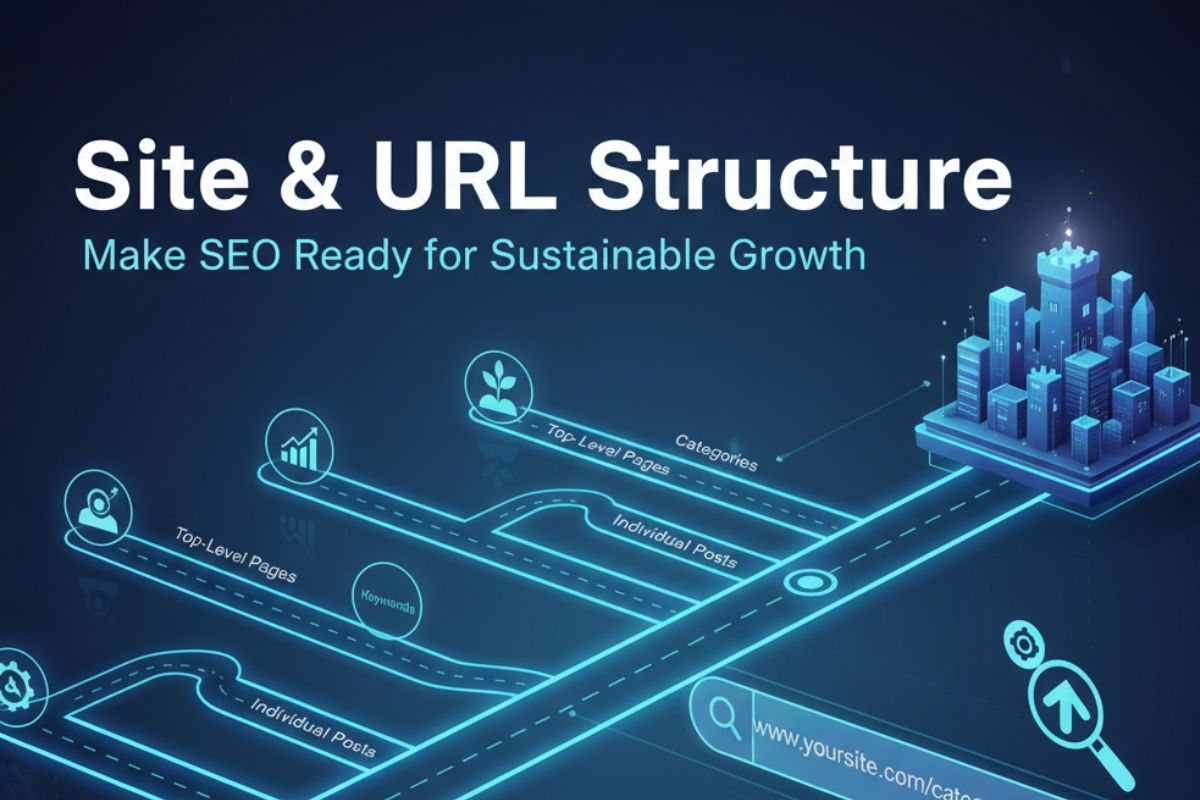In a world powered by digital marketing, SEO is not only about content and backlinks, but it is deeply rooted in the website and URL structures. Both website architecture and URL structure form the backbone of your website.
Moreover, it defines the usability and crawlability of your site – two important aspects of ensuring SEO growth.
Whether you are a small business, a large brand, or simply own a blog, you need to pay attention to your site and URL structure. Implementing them correctly will give you a competitive edge, helping your website rank faster and better than those that don’t.
Here, we will discuss the site architecture and URL structure along with the key tactics to ensure sustainable SEO growth. Let us now start with a brief introduction to the site structure.
Table of Contents
ToggleWhat is a Site Structure?
Site structure or site architecture is a term that defines the way pages on your website are organized, connected, and accessed by users and search engine bots.
A website with a good architecture makes sure that users can easily find the information they are looking for on your website. Similarly, search engine crawlers can also easily find and index pages without any difficulty.
A site structure defines the hierarchy and organization of all the pages on a website. A well-planned structure arranges content so that main categories link to subcategories, and these, in turn, connect to individual pages.
This logical flow helps both users and search engine crawlers easily understand how pages relate to each other. Moreover, a clear site structure supports better navigation, improves user experience, and strengthens overall SEO services performance by ensuring link equity is effectively distributed across the site.
What is the Importance of Site Structure for SEO?
From the start of this post, we have been linking SEO to site architecture. So, how are they connected? What is its importance? Let us answer all this.
In simpler terms, we can say that a good site architecture creates a strong foundation for search engine bots to understand and crawl your website. This is most important for SEO’s success because, if your website is not crawled properly, its visibility will be hampered. Let’s dive deep into this:
- Crawlability and Indexation
While indexing a website, search engine bots follow internal links to find new webpages. Hence, if your website is structured properly, all your important pages will be indexed, boosting their chances of high visibility for relevant searches.
- User Experience (UX)
A logical site structure improves user experience by allowing users to easily access the required information with minimum clicks. This reduces bounce rates and improves engagement metrics.
- Link Equity Flow
Proper internal linking with an organized structure allows authority to flow from high-ranking pages to deeper ones.
- Content Relevance
Linking and grouping webpages with similar content categories improves their relevance while allowing users to get detailed information on a topic. Additionally, this also allows search engine bots to deeply understand your site’s subject matter.
- Scalability
A well-planned site structure makes it easy to add new sections, product pages, or categories without affecting the SEO performance.
What Are the Key Elements of an Effective Site Structure?
It requires strategic SEO planning to build an SEO-friendly site architecture, while maintaining the right balance between technical and user-focused elements:
- Hierarchy and Depth
Make sure that the most important pages of your website are closer to the homepage. Ideally, a user should reach them within 3-4 clicks. If critical pages are deeper than that, they get buried as they are harder to find. Hence, ranking them could be tough as well.
- Internal Linking
User contextual links to interconnect related pages. This signals relevance to search engines and provides additional helpful information to users.
- Navigation Menus
Menu design must be clean and clear. Only try to include logical categories and/or key topics. Avoid adding too many sections, or else users may get overwhelmed.
- Breadcrumbs
Do not forget to add breadcrumbs navigation to your website. This helps users know where they are on your website and allows them to jump directly to the page they want. For search engines, this helps them understand the hierarchy of your website structure.
- XML Sitemap
An XML sitemap ensures that all your important URLs are crawlable, even if they aren’t fully integrated into the main navigation.
What is URL Structure and Why It Matters?
URLs are more than just addresses leading to web pages—they are key indicators of content context and organization. A well-optimized URL structure enhances crawlability, improves click-through rates, and contributes to better indexing.
A URL structure refers to the format and organization of URLs across your website. It reflects your site hierarchy, content categorization, and topical relevancy. When done strategically, URLs can communicate to both users and search engines what a page is about before even visiting it.
Example of a Good URL Structure
https://www.example.com/blog/seo/site-architecture-basics
This URL shows a clear path—starting from the main domain, followed by a content category (‘blog’), a subcategory (‘seo’), and the topic of the page (‘site-architecture-basics’).
Best Practices for SEO-Friendly URL Structure
Crafting optimized URLs demands attention to clarity, keyword relevance, and consistency. Below are the best practices that can strengthen your site’s SEO foundation.
- Keep URLs Short and Descriptive
Shorter URLs tend to perform better as they are easier to read, remember, and share. Avoid unnecessary parameters, numbers, or random strings.
- Use Keywords Naturally
Include primary keywords to reflect the page’s topic, but keep the usage organic. Avoid stuffing multiple keywords into one URL.
- Maintain Consistency
A consistent format across your entire site helps both users and search engines understand your content organization.
- Use Hyphens Over Underscores
Search engines read hyphens as word separators, while underscores join words. For example, “seo-site-structure” is more readable than “seo_site_structure”.
- Stick to Lowercase Letters
URLs are case-sensitive, and maintaining lowercase avoids duplication and technical confusion.
- Avoid Special Characters
Characters like “&”, “?”, and “%” complicate URLs and may create duplicate content issues. Clean and human-readable URLs are preferred.
- Implement HTTPS
Secure URLs with HTTPS are now essential for SEO rankings and user trust.
- Establish a Logical Folder Structure
Group related pages into relevant folders. For instance, store all blog posts under /blog/ and all product pages under /products/.
How Site Architecture and URL Structure Work Together?
The effectiveness of your SEO strategy relies on how seamlessly your site architecture aligns with URL design. Both must complement each other to form an organized, keyword-rich foundation. Site architecture defines the hierarchy, while URLs translate that hierarchy into a visual and navigational format.
For example:
- Homepage: https://www.example.com/
- Category Page: https://www.example.com/blog/
- Subcategory Page: https://www.example.com/blog/seo/
- Article Page: https://www.example.com/blog/seo/url-structure-guide/
This alignment signals a clear flow from general to specific, establishing a semantic relationship that search engines value.
Common Mistakes to Avoid
Even small architectural or URL errors can impact indexing and visibility. Avoid these pitfalls to ensure a healthy SEO foundation:
Orphan Pages
Pages not linked to any part of the site hierarchy. Always interlink newly published content.
Excessive URL Depth
Too many subfolders make URLs unnecessarily long and complex.
Redirect Chains
Multiple redirects slow down crawling and dilute link equity. Implement direct 301 redirects where necessary.
Dynamic Parameters
Excessive use of query strings (like ?id=123&type=seo) can cause duplication and poor readability.
Irrelevant Folders
Adding unrelated categories or subdomains to URLs confuses hierarchy and weakens thematic consistency.
Remember: It’s a simple truth: a solid foundation makes growth not only possible, but sustainable.




